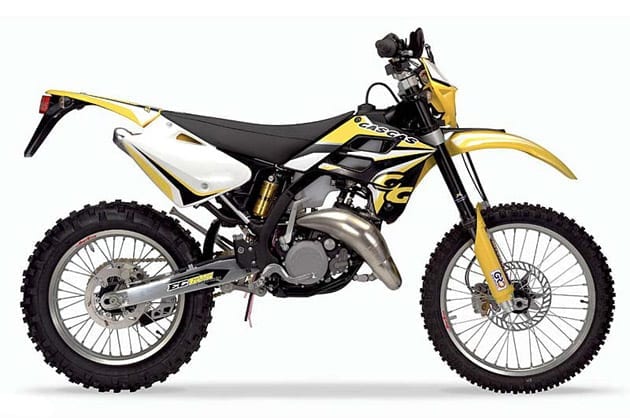Gas Gas EC125/ EC250/ EC300/ FSR450 2007 range
By TMX Archives on 2nd Aug 06

Gas Gas has decided it's time to colour its five-bike EC line-up red to coincide with the re-styling of its enduro machines. At the same time, the Spanish manufacturer has further developed its two-stroke models while making numerous changes to its 450cc four-stroke.
While the colour of the 2007 model Gas Gas enduro machines is all new, the bikes themselves aren't. Opting to develop its existing product line, rather then unveiling any new 'from the ground up' machines, of the four two-stroke and one four-stroke models produced by the Gerona factory, it is once again the mid-sized two-stroke models that will likely remain the most popular in the UK and Europe.
With the 250cc and 300cc two-stroke EC models already the company's best selling enduro machines, the fresh, contemporary new look that all of the bikes receive is both visually striking and long overdue. Giving all of the enduro models a much cleaner, sporty look, in implementing the changes, Gas Gas' majority share holders, Coller Capital, are clearly keen to show that they intend to address areas, such as styling, that had been neglected during the past few seasons.
With each of the five machines keeping their existing, yet modified, power plants, all bikes receive five chassis changes - a larger airbox, which is now accessed from under the seat and not from the side as it is at present, a new angular sub frame, a quick release seat and modified suspension settings to the 45mm Marzocchi forks and Ohlins shock.
Each of the two-stroke engines receive three modifications apiece, with the 125 getting a new power valve, a new cylinder head bracket and a lighter ignition. The 200 remains unchanged, while the 250 and 300 models get a new crankshaft counter balancer, a re-designed exhaust valve and a new Vertex piston. The changes made to the 125 are designed to simply improve performance, while the modifications to the 250 and 300 are to further smoothen the power, so Gas Gas claims.
Although the outside of the engine in the FSR450 looks all but identical to the 2006 model, numerous internal changes have been made. The crank cases are 800 grams lighter with much work having been carried out on the cylinder head, including new intake and exhaust ports. The bike is also 20mm narrower than the existing model and has the same new rear end as the two-stroke models.
With the majority of the bike's changes focused on the look of the new gassers, each bike still features numerous Japanese products such as Keihin carburettors, Kukosan ignitions, Nissin brakes and DID rims as well as continuing to feature hydraulically operated clutches and machined triple clamps and brace-less oversized bars.
The 2007 Gas Gas enduro models look much more competitive and contemporary that they do currently, due to the new styling at the rear of the bikes. By changing the back of all the enduro models they now look both much more striking and much better finished compared to the 2006 models.
Of the five models - the 125 EC, 200EC, 250EC, 300EC and 450FSR - the 250cc and 300cc two strokes are still the best of the bunch. Despite changes made to the 125cc two-stroke, the motor doesn't have the ease of use of its competitors and requires an experienced 125cc rider to get the best from it. Producing strong but short power the 125EC requires a lot of input from the rider in order to keep the machine in the power. While the machine's handling and turning characteristics are hard to fault, the complete package just isn't as easy to use.
With much effort having been made to improve the 450FSR, the '07 model Spanish thumper is a bike that riders will love or hate. Anything but an out and out race machine, the 450 is enjoyable to ride but lacks the competitiveness of its class-mates in the motor department. Like the 125, the 450's handling is difficult to fault over dry terrain and although the suspension is a little soft when the bike is ridden hard, for the average rider the bike is well suspended.
Despite there being little wrong with the delivery of the 450FSR's power it is the amount of power that will likely divide opinion among those who ride the bike. With its power feeling very much like KTM's 400EXC, or a sporty DRZ400, the bike never feels like it is 'too much of a handful' and can be ridden hard at all times.
With the 200 unchanged, the second biggest two-stroke in the Gas Gas enduro line-up will again appeal to those riders looking for a bike easier to ride than a 125 while not wanting the extra power offered by a 250.
But it is the 250cc and 300cc two-stroke machines that are again the best of the Gas Gas EC bunch, with both bikes now much smarter looking than the machines they will replace as well as having slightly smoother power deliveries. With Gas Gas having consciously decided to set the performance of the bike's motors, and the suspension settings, to favour the majority rather than the minority, the result is two easy to ride bikes with able power and well handling trail manners.
Producing strong, smooth power that in the case of the 250 doesn't hit as hard as the existing quarter litre two-stroke, both bikes pull from nothing before producing solid, tractable power. In the case of the 300, the motor produces usable power from virtually no rpms before developing into long, smooth power that riders of all abilities will find easy to use.
Specification:
ENGINE
Type: Single-cylinder, liquid-cooled two-stroke with crankcase reed-valve induction plus exhaust valve (EC models)/ Single cylinder, liquid cooled 4-stroke with 4-valve head & wet sump (FSR450 model)
Capacity: 124cc/ 249.3cc/ 297cc/ 449.3cc
Bore x Stroke: 54 x 54.5mm/ 66.4 x 72mm/ 72 x 72mm/ 97 x 60.8mm
Carburettor: Keihin PWK (EC only)
Injection System: Magneti Marelli (FSR450 only)
Clutch: Hydraulically operated multidisc (EC)/ in oil bath (FSR450)
Gearbox: 6 speeds
Ignition: Digital magnetic flywheel CDI (EC)/ Integrated within Magneti Marelli injection system (FSR450)
Transmission: Primary gearing, secondary by chain
Lubrication: 2% fuel/ oil pre-mix (EC)/ wet sump (FSR450)
Starting: Kick-starter (EC)/ Electric starter & auxiliary kick start (FSR450)
CHASSIS
Type: Deltabox made with rectangular-profile Cr-Mo tubing
SUSPENSION
Front: 45-mm upside-down Marzocchi fork
Travel: 295mm (EC)/ 290mm (FSR450)
Rear: Aluminium swing arm. Progressive system with Sachs shock absorber (Ohlins shock as optional extra)
Travel: 310mm (EC)/ 320mm (FSR450)
BRAKE
Front: 260mm disc. Nissin pump, double-piston Nissin caliper (EC)/ 300mm disc, Brembo pump and 4-piston Brembo caliper (FSR450)
Rear: 220mm disc. Nissin pump, single-piston Nissin caliper
Wheels: DID rims with spokes
TYRES
Front: 90 x 90 - 21"
Rear: 140 x 80 - 18"
Throttle grip: Domino
Kick-starter: Forged aluminium
Brake & Gear Pedals: Forged aluminium with retractable tip
DIMENSIONS
Wheelbase: 1,476mm (EC)/ 1,466mm (FSR450)
Seat Height: 940 mm (EC)/ 938mm (FSR450)
Fuel Capacity: 9.5 litres (EC)/ 7.2 litres (FSR450)
Dry Weight: 96 kg (EC125)/ 102 kg (EC 250)/ 103 kg (EC 300)/ 116 kg (FSR450)

